Relationship Spread #1
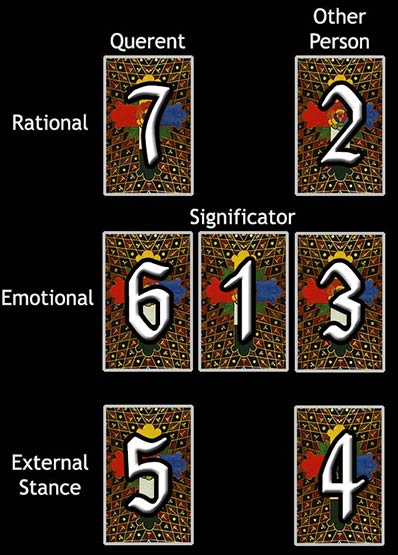
Difficulty: Easy
This tarot spread is easy to read, like a convenient chart. In this spread, court cards generally indicate actual people with the same characteristics. Knights (or corresponding princes, but not kings) and queens are meant to represent actual men and women in this tarot spread. Look for patterns in the cards as always.
Card #1 is the overall significator of the relationship. The two columns on either side of the significator characterise each individual's role in the relationship. The relationship does not have to be romantic. In fact, it could be a relationship between a person and a group, or even how two groups relate.
The top row, cards #7 & #2, is about the conscious thoughts of each person, or what they think about the relationship and likewise how they view their partner.
The middle row, cards #6 & #3, reveals the way each individual feels about the other. Emotional awareness corresponds to a person's unconscious thoughts that run deep, affecting a person in ways he or she is not fully aware of.
The bottom row, cards #5 & #4, represents the way each person behaves, in other words the stance taken regarding the relationship. The way a person acts may be genuine, but sometimes people are phony and manipulative, so it is best to weigh this card against the other person's cards to determine how they match up.
Your Relationship #1 Reading
You |
Other Person |
||
Thought |
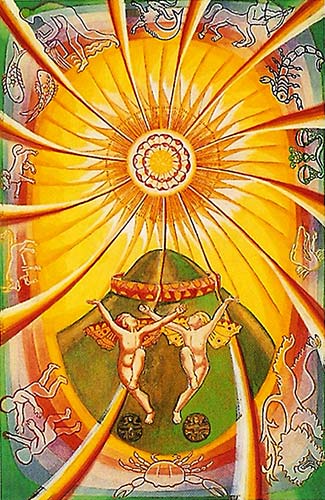 XIX – The Sun |
 III – The Empress |
|
Emotion |
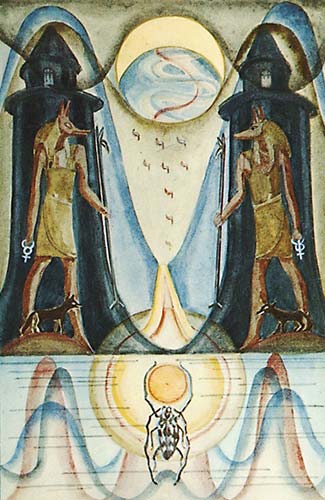 XVIII – The Moon |
The Significator  VIII – Adjustment |
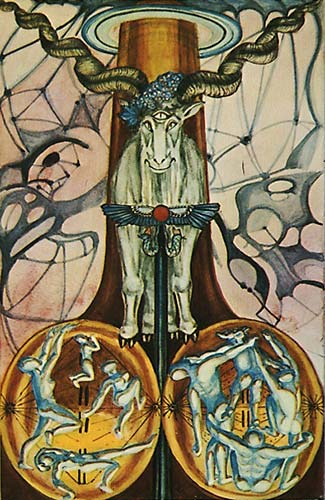 XV – The Devil |
External Stance |
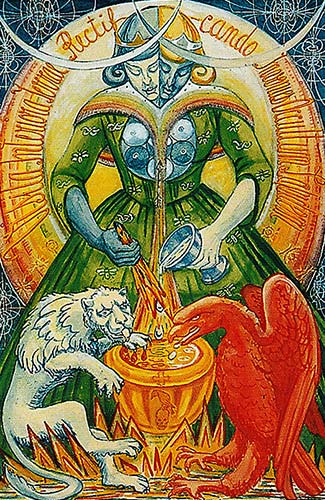 XIV – Art |
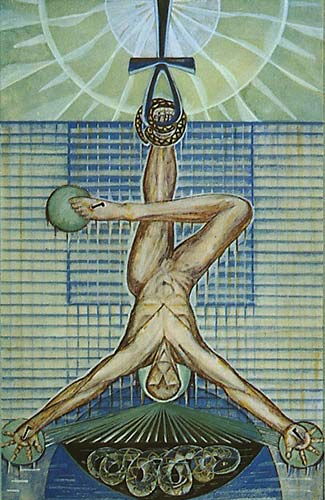 XII – The Hanged Man |

The Significator
VIII – Adjustment
(Libra, Lamed)
In the Thoth deck, the card traditionally known as Justice is renamed Adjustment, reflecting the dynamic nature of balance and the constant recalibration required to maintain harmony. Associated with Lamed, the ox-goad, it represents the guidance and discipline needed to align oneself with universal truth. Libra, the zodiac of balance and fairness, infuses the card with its themes of equity and measured judgement.
The central figure of Adjustment is a serene androgynous figure holding a sword while balancing on their toes, between a balanced pair of scales. The sword symbolises the piercing clarity of truth, while the scales represent the cosmic law of cause and effect. Their poised stance is framed by geometric patterns, emphasising precision and the mathematical order of the universe. Behind them, a brilliant green background evokes the idea of renewal and the living equilibrium of nature.
In Relationships: Adjustment highlights the importance of honesty, fairness, and mutual accountability. It encourages you to communicate openly and seek a balanced dynamic.
In Work: This card suggests success will come through careful analysis, ethical decision-making, and the ability to adapt to changing circumstances. It warns against cutting corners or ignoring the consequences of actions.
Spiritually: Adjustment signifies alignment with divine truth and the quest for inner harmony. You are called to reflect on your actions and ensure they are in alignment with your highest principles.
When ill-dignified: Adjustment warns of imbalance, dishonesty, or an inability to take responsibility for one's actions. You are advised to confront uncomfortable truths and restore equilibrium through introspection and accountability.

The Querent's Thoughts
XIX – The Sun
(Sun, Resh)
The Sun radiates with the energy of vitality, clarity, and triumphant renewal. Associated with Resh, the face, this card symbolises self-awareness, illumination, and the expression of the inner light. The Sun, as the central celestial body, embodies life, growth, and divine purpose.
The imagery is vibrant and joyous, as the golden sun blazes in the sky, surrounded by rays of light that fill the scene with warmth and illumination. Beneath it, twin children dance in a fertile landscape, representing innocence, harmony, and the unification of opposites. The background is lush with fields and flowers, a testament to the creative and nurturing power of the sun's energy. The card radiates an undeniable sense of triumph and clarity.
In Relationships: The Sun signifies joy, harmony, and mutual understanding. It brings light to connections, encouraging open communication and the sharing of love without reservation.
In Work: This card represents achievement and the realisation of goals. You are advised to embrace your success and lead confidently.
Spiritually: The Sun symbolises enlightenment, integrating the self, and realising your divine purpose. It calls you to step into your power and radiate your truth confidently.
When ill-dignified: The Sun warns of arrogance, egotism, or overexposure. You are advised to balance your confidence with humility and guard against burning out your energy.

The Other Person's Thoughts
III – The Empress
(Venus, Daleth)
The Empress is a vibrant manifestation of fertility, creativity, and the nurturing power of love. Associated with Daleth, the door, she represents the gateway to abundance and the generative forces of the divine feminine. Venus, the planet of beauty and harmony, infuses her with grace, sensuality, and the power to create life and art in all forms.
The imagery of The Empress radiates lushness and vitality. She is enthroned amidst a verdant paradise, symbolising her role as the Earth Mother. Her gown flows in harmonious patterns of red, green, and gold, adorned with pomegranates—a symbol of fertility and the mysteries of creation. In her right hand, she holds a lotus flower, representing purity and spiritual unfolding. At her feet rests a shield emblazoned with an alchemical double eagle. She gazes at a dove, a symbol of the Holy Spirit, while the aura around her suggests industrious creativity and the interconnectedness of life.
In Relationships: The Empress signifies profound connection, nurturing energy, and the blossoming of relationships. She encourages you to cultivate love with patience and care, allowing it to flourish naturally.
In Work: This card indicates a fertile period for creativity and growth. You are encouraged to trust your creative instincts and nurture your projects with love and dedication, knowing abundance will follow.
Spiritually: The Empress represents the divine source of life and the sacred connection to nature. She calls you to honour your creative power and embrace the beauty and abundance within and around you.
When ill-dignified: The Empress warns of stagnation, overindulgence, or smothering tendencies. You are advised to examine whether your actions are rooted in genuine love or in a need to control and ensure you are not sacrificing yourself for others.

The Querent's Emotions
XVIII – The Moon
(Pisces, Qoph)
The Moon symbolises illusion, intuition, and the mysterious depths of the subconscious. Associated with Qoph, the back of the head, this card delves into the primal and instinctual aspects of the psyche. Pisces, the zodiac of dreams and mysticism, enhances the card's themes of mystery and emotional depth.
The imagery is haunting and enigmatic. A path winds through barren terrain, flanked by twin towers that suggest gateways to the unknown. Above, the moon dominates the sky, casting an eerie light that obscures as much as it reveals. Crawling on the path is a scarab beetle carrying the solar disk, symbolising the emergence of light from darkness. The waters below teem with life, representing the fertile chaos of the subconscious.
In Relationships: The Moon represents emotional complexity and hidden dynamics. It encourages you to trust your intuition and uncover underlying truths.
In Work: This card suggests uncertainty or confusion. You are advised to navigate carefully, relying on intuition and patience to discern the best path forward.
Spiritually: The Moon symbolises the journey through the subconscious and the mysteries of the soul. It calls you to explore your inner depths and embrace the wisdom found in dreams and intuition.
When ill-dignified: The Moon warns of deception, confusion, or fear of the unknown. You are advised to confront your fears and seek clarity amidst uncertainty.

The Other Person's Emotions
XV – The Devil
(Capricorn, Ayin)
The Devil symbolises bondage, materialism, and the potent, often misunderstood forces of desire and instinct. Associated with Ayin, the eye, this card invites a piercing vision into the illusions and structures that bind us. Capricorn, the zodiac of ambition and discipline, infuses the card with themes of mastery over material and earthly limitations.
The central figure is a goat before a phallic structure, symbolising generative power and material dominance. This card is seething with esoteric symbols of competition within a person. The background, webbed in deep, earthy tones, suggests the shadowy nature of the forces at play. The card is alive with energy, hinting at temptation and the potential for liberation.
In Relationships: The Devil represents intense, often obsessive attraction. It can warn of relationships rooted in control or dependency, urging you to assess whether your connections are serving your growth.
In Work: This card suggests material success, often achieved through relentless ambition. However, it warns of becoming enslaved by wealth or status and advises balancing ambition with higher values.
Spiritually: The Devil symbolises the necessity of confronting and integrating one's shadow self. It calls you to transcend material attachments and awaken to higher truths.
When ill-dignified: The Devil warns of oppression, excessive materialism, or destructive desires. You are advised to liberate yourself by recognising and overcoming illusions and self-imposed limitations.

The Querent's External Stance
XIV – Art
(Sagittarius, Samekh)
Art, traditionally called Temperance, represents the alchemical process of transmutation and the blending of opposites. Associated with Samekh, the prop, this card signifies the support and structure needed to integrate seemingly opposing forces. Sagittarius, the zodiac of exploration and synthesis, infuses the card with visionary energy and optimism.
The central figure is a radiant androgynous being with two faces engaged in an alchemical act of union. They pour liquid from one vessel into another, blending fire and water, symbolising the merging of opposites to create something entirely new. Around them, symbols of the zodiac and alchemical glyphs emphasise the universal nature of this process. The golden background radiates the light of inspiration and higher purpose, while the stream of power arching above the pot signifies hope and divine harmony.
In Relationships: Art represents the balance and integration of differences. It encourages you to find harmony through patience, communication, and mutual understanding.
In Work: This card signifies success achieved through creativity, innovation, and the ability to blend diverse elements into a unified whole. You are advised to embrace flexibility and trust in your creative process.
Spiritually: Art symbolises the quest for inner balance and the alchemical transformation of the self. It calls you to embrace your contradictions and to unite yourself in service of a higher purpose.
When ill-dignified: Art warns of imbalance, lack of focus, or the inability to harmonise opposing forces. You are advised to recalibrate and approach your challenges with patience and creativity.

The Other Person's External Stance
XII – The Hanged Man
(Water, Mem)
The Hanged Man represents surrender, transformation, and the wisdom gained through self-sacrifice. Associated with Mem, the waters, this card embodies the flow of unconscious depths and the mysteries that lie beyond the material world. It is not a card of suffering but one of enlightenment through letting go.
The central figure is suspended upside-down, forming a cross with his legs, a symbol of balance and sacrifice. His arms form a triangle, evoking the union of spirit and matter. Behind him, the swirling blue-green background suggests the ocean of the subconscious. The serene expression on his face reflects the tranquillity found in surrendering to a greater truth. Around him, rays of light emanate, signifying the revelation that arises from this state of suspension.
In Relationships: The Hanged Man suggests a need for patience, selflessness, and understanding. It encourages you to see things from your partner's perspective and release control.
In Work: This card indicates a period of pause or sacrifice, where immediate goals may need to be set aside for long-term growth. You are advised to trust in the process and focus on the bigger picture.
Spiritually: The Hanged Man symbolises enlightenment achieved through surrender and the release of ego. It calls you to embrace the transformative power of stillness and contemplation.
When ill-dignified: The Hanged Man warns of stagnation, resistance to change, or clinging to outdated beliefs. You are advised to let go of what no longer serves you and embrace the wisdom of surrender.